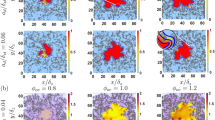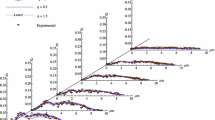Abstract
In this paper we analyzed the model of polydisperse fuel spray flame by using the sectional approach to describe the droplet-droplet interaction within the spray. The radii of the droplets are described by a probability density function. Our numerical simulations include a comparative analysis between three empirical droplet size distributions: the Rosin–Rammler distribution, the log-normal distribution and the Nakiyama–Tanasawa distribution. The log-normal distribution was found to produce a reasonable approximation to both the number and volume size distribution function. In addition our comparative analysis includes the application of the homotopy analysis method which yields convergent solutions for all values of the relevant parameters. We compared the above results to experimental fuel spray data such as \({\textit{Tetralin}}\), \(n-{\textit{Decane}}\), and \(n-{\textit{Heptane}}\).






Similar content being viewed by others
Abbreviations
- A :
-
Pre-exponential rate factor
- B :
-
Universal gas constant
- C :
-
Vaporization coefficient
- E :
-
Activation energy
- \(c_{p}\) :
-
Specific heat of capacity
- D :
-
Diffusion
- L :
-
Liquid evaporation energy (i.e., latent heat of evaporation, enthalpy of evaporation)
- Le :
-
Lewis number
- m :
-
Mass
- N :
-
Number of collisions
- P :
-
Probability
- p :
-
Pressure
- Q :
-
Heat of reaction
- \(Q_{i}\) :
-
\(i=0, 1, 2, 3\) the distribution function of the ith moment
- R :
-
Radius of droplet
- T :
-
Temperature
- u :
-
Velocity
- V :
-
Volume
- v :
-
Average relative velocity
- \(^{*}\) :
-
Denotes the non dimensional parameter
- \(\rho\) :
-
Density
- \(\eta\) :
-
Dimensionless parameter defined in Eq. (2.11)
- \(\mu\) :
-
Dimensionless parameter defined in Eq. (2.11)
- \(\alpha\) :
-
Dimensionless parameter defined in Eq. (2.11) and refer to volumetric droplet content
- \(\lambda\) :
-
Thermal conductivity
- coll :
-
Collision
- cell :
-
Cell of parcel
- F :
-
Fuel
- f :
-
Flame
- rel :
-
Relative
- 0:
-
Refers to condition at \(x=0\)
- O :
-
Oxygen
- g :
-
Gas
References
Mendes MAA, Pereira JMC, Pereira JCF (2008) A numerical study of the stability of one-dimensional laminar premixed flames in inert porous media. Combust Flame 153:4
Kaufmann D, Roth P (1990) Numerical simulation of one-dimensional laminar flames propagating into reacting premixed gases. Combust Flame 80:3
Clarke JF (1975) Parameter perturbations in flame theory. Prog. Aerosp. Sci. 16:1
Buckmaster J, Ludford GSS (1982) Theory of laminar flames. Cambridge University Press, Cambridge
Polymeropoulos CE (1974) Flame propagation in a one-dimensional liquid fuel spray. Combust Sci Technol 9:5–6
Satil PB, Sichel M, Nicolls JA (1978) Analysis of spray combustion in a research gas turbine combustor. Combust Sci Technol 18:21–31
Sirignano WA (1983) Fuel droplet vaporization and spray combustion theory. Prog Energy Combust Sci 9:4
Law CK (1982) Recent advances in droplet vaporization and combustion. Prog Energy Combust Sci 8:3
Chiu HH, Liu TM (1977) Group combustion of liquid droplets. Combust Sci Technol 17:3–4
Sankaran V, Menon S (2002) LES of spray combustion in swirling flows. J Turbul 3:1505–1510
Brzustowski TA, Twardus EM, Wojcicki S, Sobiesiak A (1979) Interaction of two burning fuel droplets of arbitrary size. AIAA J 17:11
Chiu HH, Kima HY, Crokea EJ (1982) Internal group combustion of liquid droplets. In: Symposium (international) on combustion, vol 19, pp 1
Stiesch G (2003) Modeling Engine spray and combustion processes. Heat and mass transfer. Springer, Berlin
Lefebvre AH (1989) Atomization and sprays. Hemisphere Publishing Corporation, Washington, DC
Liao SJ (1992) Proposed homotopy analysis techniques for the solution of nonlinear problems. Ph.D. Thesis, Shanghai, Shanghai Jiaotong University
Turkyilmazoglu M (2015) Is homotopy perturbation method the traditional Taylor series expansion. Hacet J Math Stat 44:3
Das S, Vishal K, Gupta PK, Saha SR (2011) Homotopy analysis method for solving fractional diffusion equation. Int J Appl Math Mech 7:9
Liao SJ (2005) Comparison between the homotopy analysis method and homotopy perturbation method. Appl Math Comput 169:1186–1194
Turkyilmazoglu M (2012) The Airy equation and its alternative analytic solution. Phys Scr 86:5
Turkyilmazoglu M (2012) An effective approach for approximate analytical solutions of the damped duffing equation. Phys Scr 86:1
Turkyilmazoglu M (2011) An optimal analytic approximate solution for the limit cycle of duffing-van der pol equation. J Appl Mech ASME 78:2
Tambour Y (1980) A sectional model for evaporation and combustion of sprays of liquid fuels. Isr J Technol 18:1–22
Silverman I, Greenberg JB, Tambour Y (1991) Asymptotic analysis of a premixed polydisperse spray flame. SIAM J Appl Math 51:5
Adam S, Schnerr GH (1997) Instabilities and bifurcations of non-equilibrium two-phase flows. J Fluid Mech 348:1
Sowa WA (1992) Interpreting mean drop diameters using distribution moments. At. Sprays 2:1
O’Rourke PJ, Bracco FV (1980) Modelling of drop interaction in thick sprays and comparison with experiment. In: Stratified charge auto engineers conference. IMechE, London
Beck JC, Watkins AP (2002) On the development of spray sub models based on droplet size moments. J Comput Phys 182:1
Williams FA (1985) Combustion theory, 2nd edn. Benjamin/Cummings, Menlo Park
Katoshevski D (2006) Characteristics of spray grouping/ non-grouping behavior. Aerosol Air Qual Res 6:1
Miesse CC, Putnam AA (1957) Mathematical expressions for drop-size distributions. Injection and combustion of liquid fuels, Section II, WADC Technical Report 56-344, Mattelle Memorial Institute
Beck JC, Watkins AP (2002) On the development of spray sub-models based on the droplet size moments. J Comput Phys 182:2
Beck JC, Watkins AP (2003) On the development of spray models based on the droplet size moments. Proc R Soc A 459:2034
Beck JC, Watkins AP (2003) Simulation of water and other non-fuel sprays using a new spray model. At. Sprays 13:1
Mastroberardini A (2011) Homotopy analysis method applied to electrohydrodynamic flow. Commun Nonlinear Sci Numer Simul 16:2730–2736
Liao SJ (2003) Beyond perturbation: introduction to the homotopy analysis method. Chapman and Hall/CRC Press, Boca Raton
Ku X, Hagmeijer R (2015) A new reduced model for the moments of droplet size distribution in condensing flow. Int J Numer Methods Heat Fluid Flow 25(2):320–332
Frank-Kamenetskii DA (1969) Diffusion and heat exchange in chemical kinetics. Plenum Press, New York
Turkyilmazoglu M (2014) Advances in the homotopy analysis method, Chapter 5. World Scientific, Singapore
Liao SJ (2009) Notes on the homotopy analysis method: some definitions and theorems. Commun Nonlinear Sci Numer Simul 14
Author information
Authors and Affiliations
Corresponding author
Rights and permissions
About this article
Cite this article
Nave, O., Lehavi, Y., Ajadi, S. et al. Analysis of polydisperse fuel spray flame. Heat Mass Transfer 53, 649–660 (2017). https://doi.org/10.1007/s00231-016-1844-z
Received:
Accepted:
Published:
Issue Date:
DOI: https://doi.org/10.1007/s00231-016-1844-z




